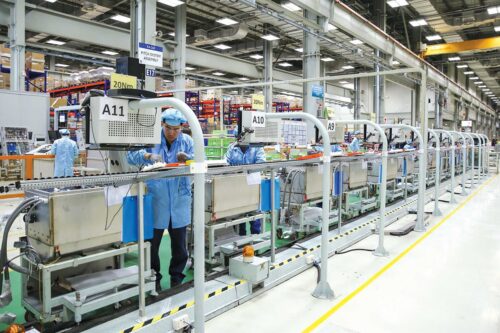The article by Mr. Đinh Hồng Kỳ, published in Forbes Vietnam on August 5, 2025.
The U.S. imposition of a 20% tariff from August 1, 2025, acts as a catalyst compelling Vietnam to reshape its growth model — transitioning from being a subcontractor to mastering the value chain, harnessing technology, and becoming the architect of its own path

From Trade Triumph to Tariff Shock
In 2024, Vietnam exported $120 billion worth of goods to the U.S., while importing only $13.1 billion, resulting in a surplus of $106.9 billion — the third-largest globally after China and Mexico.
However, in Washington’s view, such a trade imbalance is dangerously lopsided. As a response, the re-elected Trump administration imposed reciprocal tariffs on nearly 100 trading partners, including a 20% tariff on Vietnam starting August 7, 2025.
Moreover, goods merely transshipped through Vietnam—with low domestic value-added and primarily produced elsewhere—could face tariffs up to 40%.
Though this rate is lower than the initially announced 46%, thanks to high-level negotiations, it still triggered widespread concern among businesses.
This policy affects not only vulnerable sectors like textiles, wood, and seafood, but also export-heavy industries such as electronics, equipment, and plastics. They now face pressure to revise business strategies, reposition markets, and restructure supply chains.

Crucially, observers note that the U.S. applies the principle: “deficit-based tariffs.” With nearly 90% trade deficit, Vietnam is seen as implicitly taxing U.S. goods equivalently.
Whether debatable or not, this approach signals the closing chapter of unconditional trade privileges — and if Vietnam doesn’t adapt swiftly, this tariff shock may be the first of many .
FDI: A Two-Sided Sun
The tariff shock serves as a wake-up call, highlighting the downside of a growth model overly reliant on export-driven, foreign-input-heavy strategies and exposing weaknesses in Vietnam’s value chain.
A FiinGroup report notes that by end 2024, only 21.6% of Vietnam’s export value to the U.S. came from domestic firms; the remaining 78.4% was from FDI, chiefly from China, South Korea, and Taiwan. Domestic firms are nearly absent in sectors like electronics, footwear, and plastics.

This dominance underscores a dual reality: while FDI has been pivotal for industrialization, job creation, export income, and GDP growth, it also reveals fragility: low value-addition, reliance on imported inputs, and profit repatriation. Many FDI firms treat Vietnam as an assembly hub -importing components, labeling goods “Made in Vietnam,” and exporting them. When the U.S. probes origin and launches tariffs on “disguised goods,” Vietnam-though unintentionally-suffers.
Three Strategic Vulnerabilities
• Thin Industrial Base: Domestic value addition remains minimal. In electronics — Vietnam’s largest export sector — 90% of component value is imported, mostly from China. This undermines compliance with strict rules of origin under FTA or markets like the U.S. and EU.
• Domestic Firms’ Weak Position: Limited competitiveness and integration into global value chains persist. FDI firms offer little tech transfer, and policies favor FDI over domestic firms in land, capital, and infrastructure access.
• Growth Model Anchored on Two Pillars: Export and FDI are the twin engines. With the U.S. tightening export channels, both wobble. FDI inflows can shift to more stable markets, and supply chains may diversify. A PwC survey shows 44% of firms are diversifying production, and 34% are renegotiating contracts to source alternatives.
Opportunity Amid the Storm
Despite the tariff turmoil, positive signs emerge. In the first half of 2025, Vietnam attracted over $21.5 billion in newly registered FDI—the highest in 15 years. Capital flows are shifting into higher-value sectors like electronics, semiconductors, water treatment, and logistics .
Cities like Hanoi, Bac Ninh, and Hai Phong report surges in FDI, driven by R&D, green manufacturing, and high-tech projects.
Additionally, major Vietnamese groups such as Vingroup, Viettel, and FPT aim to break into global value chains with “make in Vietnam” products.
These developments suggest that Vietnam can recalibrate its growth model—if it harnesses external pressures to drive internal reform.

Four Policy Recommendations
Reposition the FDI Strategy
Transition from indiscriminate FDI attraction to selecting high-quality projects. Incentivize FDI with high-tech content, technology transfer, talent training, domestic integration, and linkages with Vietnamese firms. Project review should assess technology, environmental, and local integration impacts.
Empower Vietnamese Enterprises
Accelerate FTAs with the U.S. to lock in tariff rates and reduce uncertainty. Push for recognition as a market economy and removal of high-tech export restrictions. Comply with commitments on origin fraud prevention and customs transparency.
Diversify Markets and Supply Chains
Avoid dependence on one basket. Expand exports beyond the U.S. to the EU, East Asia, and the Middle East via new FTAs. Develop domestic supporting industry and seek alternative suppliers beyond China to enhance supply chain resilience.
Strengthen Legislation and Institutions
Finalize bilateral trade negotiations with the U.S. to stabilize tariffs; push for market economy status and removal of restrictions; and ensure transparency and integrity in trade operations .

Conclusion: Redesign the Game
Vietnam once prospered by embracing FDI and leveraging U.S.–China trade tensions. But past success can become today’s vulnerability without timely restructuring. In an increasingly uncertain world, no nation can sustainably develop by remaining a subcontractor. Vietnam must evolve into a game designer, mastering technology, brand, and value chains. Ultimately, this 20% tariff shock might just be the impetus for a more self-reliant, resilient growth model.
Dinh Hong Ky
Chairman of Secoin Corporation
Chairman of the Ho Chi Minh City Construction & Building Materials Association (SACA)
Chairman of the Ho Chi Minh City Green Business Association (HGBA)
Vice Chairman of the Ho Chi Minh City Business Association (HUBA).
Link to article on Forbes Vietnam: https://forbes.vn/cu-hich-tu-washington-tai-co-cau-mo-hinh-tang-truong


